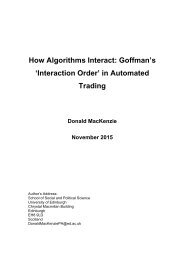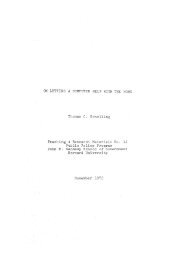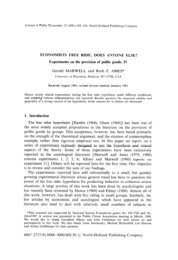n3-al-mukhatabat-journal
n3-al-mukhatabat-journal
n3-al-mukhatabat-journal
You also want an ePaper? Increase the reach of your titles
YUMPU automatically turns print PDFs into web optimized ePapers that Google loves.
VIII. Conclusion<br />
In this paper we addressed the problem domain limits of of models in view of the<br />
current shift of contemporary scientific thought from empathies on the theory to<br />
the concept of modeling. The question raised is whether models can span both<br />
natur<strong>al</strong> and human sciences? or any model should be limited to one of the two<br />
basic fields, in the same way as our scientific theories work today.<br />
This question is of speci<strong>al</strong> importance in view of the current obstacles that<br />
confront the currently prevailing mechanistic model of nature. Specific<strong>al</strong>ly, we<br />
question the possibility of formulating a non-mechanistic model that covers both<br />
'natur<strong>al</strong>' and human sciences without reducing either of them to physics. In other<br />
words, on the basis of taking modeling as a pragmatic tool to be used in<br />
accordance to our purposes, modeling is presented here as a tool for bridging<br />
'natur<strong>al</strong>' and human sciences.<br />
In order to answer such a question, we first introduced the concept of 'gener<strong>al</strong><br />
model of nature', which is based on three basic presuppositions, the fin<strong>al</strong><br />
constituents of existence, the vertic<strong>al</strong> relations between the successive levels of<br />
existence, and the horizont<strong>al</strong> relations that govern change within every level.<br />
Using such a construct we presented the 'mechanistic model of nature' as a<br />
particular instance of such a gener<strong>al</strong> form of the concept of the model of nature.<br />
In the mechanistic model, the fin<strong>al</strong> constituents are the indivisible atoms, the<br />
vertic<strong>al</strong> relation is reduction and the horizont<strong>al</strong> relation is the Newtonian<br />
mechanics. Following such characterization we presented the ch<strong>al</strong>lenges that<br />
confronted the mechanistic model which have not been overcome yet.<br />
Specific<strong>al</strong>ly, the three basic presuppositions of such a model, which are the<br />
indivisible atoms, reduction and determinism are now completely refuted. This<br />
situation points out clearly to the need for an <strong>al</strong>ternative model.<br />
In the fin<strong>al</strong> section of this paper, in order to show that the concept of modeling<br />
can in principle close the gap between natur<strong>al</strong> and human sciences, we<br />
presented in some details how to achieve such a go<strong>al</strong>. On the basis of<br />
contemporary advancement of scientific thought, especi<strong>al</strong>ly the appearance of<br />
QM, as well as the newly admitted views in philosophy of science, such<br />
AL-MUKHATABAT Numéro 03 Année 01/2012 لىولأا ةن سلا 30 ددعلا تابطانا<br />
138<br />
ISSN: 1737-6432







